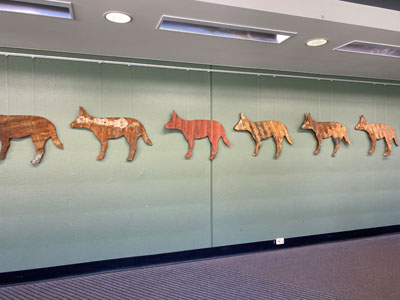
Corrugated Iron Dogs 1 - 7 from Eye of the Dog Series
Ingo Kleinert
1995
Weathered corrugated iron, wall art
Purchased on 1995
Griffith University Art Collection
These seven corrugated iron dogs are from a larger pack of approximately 400 which were installed on the lawns of Parliament House in 1995. The original template for the work was a metal cattle dog-shaped sign found nailed to roadside posts in north-west NSW, near the dingo fence.
The work references rural Australian life – the corrugated iron came from walls and roofs of shearing sheds, cattle yard fences, shooting targets, water tanks, and other iconic features of the Australian station landscape. The patterns of wear and tear and weathering make each dog unique.
On his regular travels throughout Australia, Kleinert saw a folk-art tradition practised by farmers and rural workers – animals cut from flat iron to scare off potential pests. He found the makers wouldn’t call themselves artists or be recognised by others as such, yet had made the creative leap from the functional to the irrational much the same as artists do. Kleinert’s dogs refer to this tradition. They also refer to a deeper human condition associated with barriers and ignorance.
On a trip to the outback in 1989 Kleinert crossed the dingo fence between NSW and Queensland around the time that the Berlin Wall fell. It led to a realisation that the era’s developments in modern information technology were making it virtually impossible to keep people oppressed and uninformed. To this end, Kleinert’s pack of dogs also represent the released people of his birthplace Bunzlau, also known as Bolesławiec and now a part of Poland, which he was finally able to revisit in 1993.